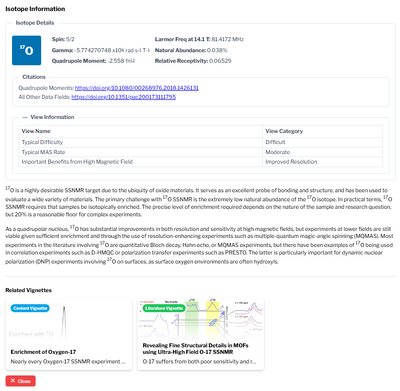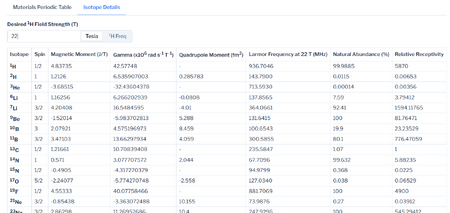Materials Periodic Table: Difference between revisions
Mmaciejewski (talk | contribs) |
Mmaciejewski (talk | contribs) No edit summary |
||
| (3 intermediate revisions by the same user not shown) | |||
| Line 1: | Line 1: | ||
{{KB_navigation}} | |||
== Overview == | == Overview == | ||
The '''Materials Periodic Table''' represents a condensed area where users may discover the applicability of performing NMR on NMR active isotopes for each of the elements in the periodic table. | The '''Materials Periodic Table''' represents a condensed area where users may discover the applicability of performing NMR on NMR active isotopes for each of the elements in the periodic table. | ||
| Line 4: | Line 6: | ||
== Periodic Table Views == | == Periodic Table Views == | ||
The '''Materials Periodic Table''' shows the NMR active nuclei for each element. ''Note that a small number of impractical isotopes are ignored when more than two isotopes exist for a given element. Elements with no NMR active isotopes are shown with no isotope number.'' | The '''Materials Periodic Table''' shows the NMR active nuclei for each element. ''Note that a small number of impractical isotopes are ignored when more than two isotopes exist for a given element. Elements with no NMR active isotopes are shown with no isotope number.'' | ||
[[File:Periodic-table.png|thumb|600x600px|Periodic table of isotopes showing NMR properties]] | |||
Each of the elements are color coded depending on the '''View''' with a legend describing the color code in the center. When a nuclei is hovered over the central display also shows the: | Each of the elements are color coded depending on the '''View''' with a legend describing the color code in the center. When a nuclei is hovered over the central display also shows the: | ||
| Line 17: | Line 19: | ||
=== Color Coded Views === | === Color Coded Views === | ||
Different views may be selected from the "Select a View" pull-down menu to see color coded views of the periodic table. | |||
* Typical Difficult | * Typical Difficult | ||
* Typical MAS Rate | * Typical MAS Rate | ||
| Line 23: | Line 25: | ||
== Isotope Information Page == | == Isotope Information Page == | ||
[[File:Isotope-information.png|thumb|400x400px|Isotope Information KB Content Area]] | |||
Clicking on an isotope opens an '''Isotope Information Page''' that contains: | Clicking on an isotope opens an '''Isotope Information Page''' that contains: | ||
| Line 41: | Line 44: | ||
=== Isotope Content Area === | === Isotope Content Area === | ||
In the same vein as the KB Content Areas for non-expert KBs, each isotope may contain information including: | In the same vein as the [[Knowledgebases for Non-Experts|KB Content Areas]] for non-expert KBs, each isotope may contain information including: | ||
* An HTML blurb | * An HTML blurb | ||
* Links to Related Content and Literature Vignettes | * Links to Related Content and [[Vignette Library|Literature Vignettes]] | ||
* Links | * Links to related [[Knowledgebase Datasets|KB datasets]] | ||
== Isotope Details Page == | == Isotope Details Page == | ||
[[File:Isotope-table.png|thumb|450x450px|Table of NMR properties of Isotopes]] | |||
The isotope details page shows a table with detailed information for each isotope including: | The isotope details page shows a table with detailed information for each isotope including: | ||
Latest revision as of 15:28, 18 June 2025
Overview
The Materials Periodic Table represents a condensed area where users may discover the applicability of performing NMR on NMR active isotopes for each of the elements in the periodic table.
Periodic Table Views
The Materials Periodic Table shows the NMR active nuclei for each element. Note that a small number of impractical isotopes are ignored when more than two isotopes exist for a given element. Elements with no NMR active isotopes are shown with no isotope number.

Each of the elements are color coded depending on the View with a legend describing the color code in the center. When a nuclei is hovered over the central display also shows the:
- Element name
- Nuclear Spin Number
- Natural Abundance
- Larmor Frequency
- Relative Receptivity
- Quadrupole Moment
The Larmor frequency is based on a 14.1 T magnetic field strength (600 MHz), but may be changed to any desired value.
Color Coded Views
Different views may be selected from the "Select a View" pull-down menu to see color coded views of the periodic table.
- Typical Difficult
- Typical MAS Rate
- Importance Benefits from High Magnetic Field
Isotope Information Page

Clicking on an isotope opens an Isotope Information Page that contains:
Isotope Details
- Nuclear Spin
- Larmor Frequency
- Gamma
- Natural Abundance
- Quadrupole Moment
- Relative Receptivity
Citations
Links to citations related to using the isotope in an NMR study
View Information
Shows each of the defined View Names and what category the isotope has been placed. Note that not all isotopes have been defined for each view so some may be empty
Isotope Content Area
In the same vein as the KB Content Areas for non-expert KBs, each isotope may contain information including:
- An HTML blurb
- Links to Related Content and Literature Vignettes
- Links to related KB datasets
Isotope Details Page

The isotope details page shows a table with detailed information for each isotope including:
- Spin
- Magnetic Moment (J/T)
- Gamma (x106 rad s-1 T-1)
- Quadrupole Moment (fm2)
- Larmor Frequency at 14.1 T (MHz)
- Natural Abundance (%)
- Relative Receptivity relative to 13C
Note that the desired field strength maybe input in Tesla or 1H frequency and the Larmor Frequency for each isotope will adjust automatically